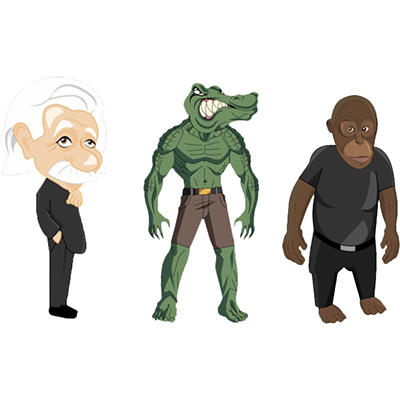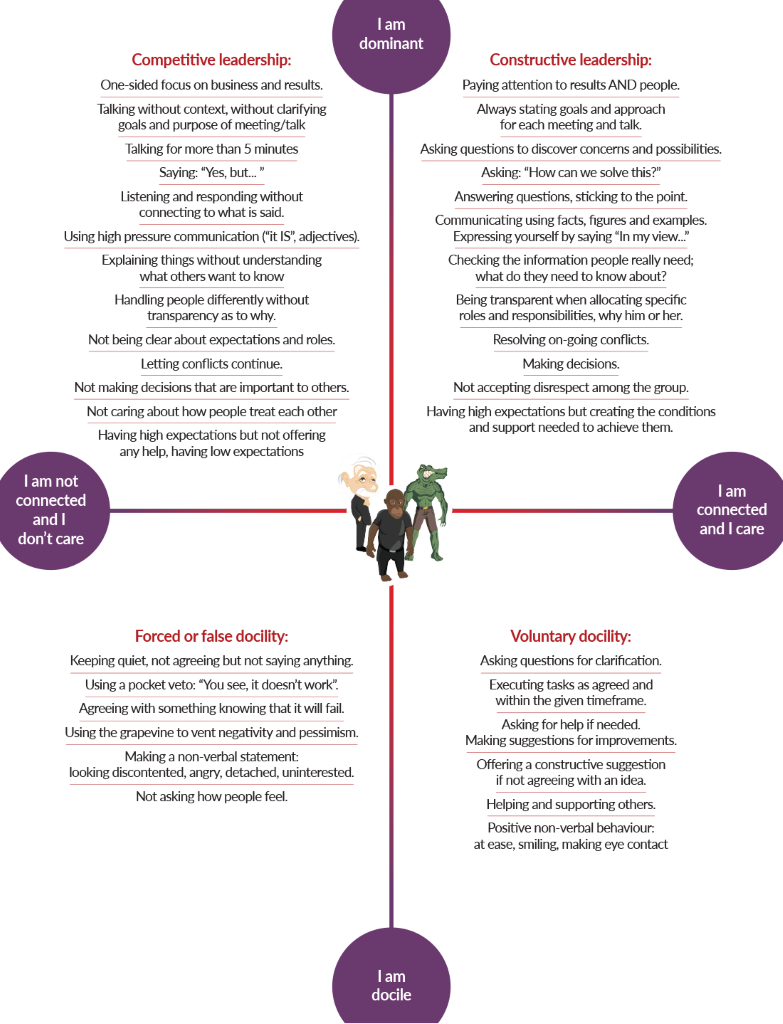When using the leadership compass, it is important to highlight the following key points (practical examples follow in the next part of these articles):
The difference between inside, outside and other side.
In my experience, it is common to find a difference between the inside (what do you intend to communicate), the outside (what you do and say) and the other side (how your behaviour is perceived).
Over the past few decades I’ve coached many leaders who intended to be constructive leaders but who displayed behaviour that caused others to perceive them as competitive leaders. Positive intentions are a good start but they alone are not good enough. What counts is your behaviour and how it is perceived. You are responsible for this behaviour and its perception. It is your responsibility to manage both.

But, of course, leaders too have a crocodile and a monkey within. Leaders are often under significant pressure to perform and to keep their position. It should be no surprise, then, that their crocodile and monkey are often challenged. This is probably why there is often a difference between the inside and outside.
Leaders are, or at least feel, under pressure to keep up appearances which lead to all kinds of behaviours that do not necessarily correspond with their intentions.
At this point, I feel it necessary to state that, in my view, personality is a product of the three brains interacting with each other. Basic instincts and internal emotions (related to maintaining or expanding survival, reproduction and social position) lead to the creation of rational constructs in the form of values, norms and convictions, which in turn leads to outside behaviour within an external context.
But, along with this inside-out influence there is also an outside-in influence. An external context can demand new behaviours, reshape norms, values and convictions and influence basic emotions.
That’s why it is crucial for leaders to understand themselves in order to identify the elements that influence their behaviour and how they choose to manage and develop their behaviour in their own interest, that of their co-workers and that of the organization.
I feel that knowing yourself and daring to be honest with yourself and others will lead to authentic leadership. It is this kind of leadership that connects highly to the emotional brain and that will successfully engage and motivate people.
The Laws of Interaction, Action and Reaction
According to the Rose of Leary, behaviour triggers behaviour. For the vast majority of people, dominant behaviour triggers docile behaviour and the other way around. However, caring behaviour triggers caring behaviour and uncaring behaviour will evoke uncaring behaviour.

So, constructive leadership will trigger voluntary docility and voluntary docility will trigger constructive leadership.
Competitive leadership will trigger forced or false docility and forced or false docility will trigger competitive leadership.
The latter is often a crucial pitfall for leaders as they often do not realize that they are being pushed into an aggressive competitive leadership style by a resistant team. The challenge is not to succumb to this pitfall as competitive leadership will only reinforce and feed resistance. Furthermore, the leadership style triggered by resistance will be used as a justification for that same resistance!
So, perhaps you are fully prepared to explain in detail the facts about a new change. But how are you communicating with the monkey and the crocodile? They will decide if people follow you or not!
In the next part I give examples that will position you in the different corners of behaviour. Your behaviour will determine if you get emotional and fundamental support for change or not. The list is not exhaustive but it illustrates some of the most common situations that I see almost every day. I see leaders losing or winning the “battle” by being on the competitive or constructive side of the leadership compass.

Literature
- Coaching with the Brain in Mind. David Rock and Linda J. Page, Wiley 2009
- Change Your Brain, Change Your Life: The Breakthrough Program for Conquering Anxiety, Depression, Obsessiveness, Anger, and Impulsiveness. Daniel G. Amen, Potter/Ten Speed/Harmony, 1999
- The Brain and Emotional Intelligence: New Insights. Daniel Goleman, More than sound LLC, 2011
- Mindsight: The New Science of Personal Transformation. Daniel J. Siegel, Bantam, 2009
- Hardwired Humans. Andrew O’Keeffe, Round table press, 2011
- The Surprising Truth About What Motivates Us. Daniel Pink, Riverhead Hardcover, 2009
- Interpersonal diagnosis of personality, Timothy Leary, 1957
